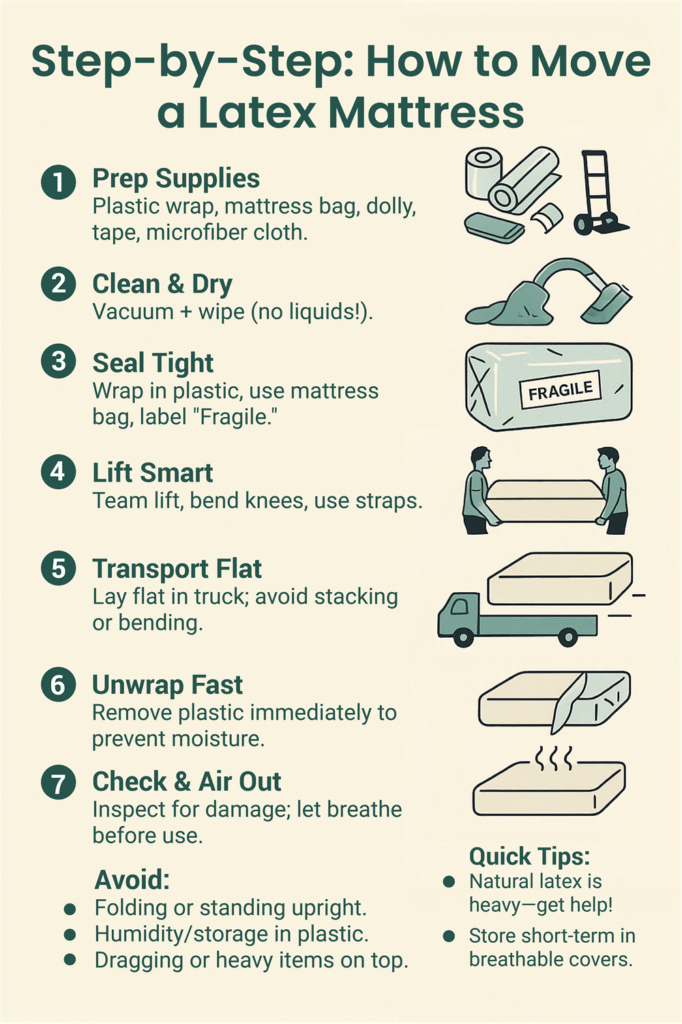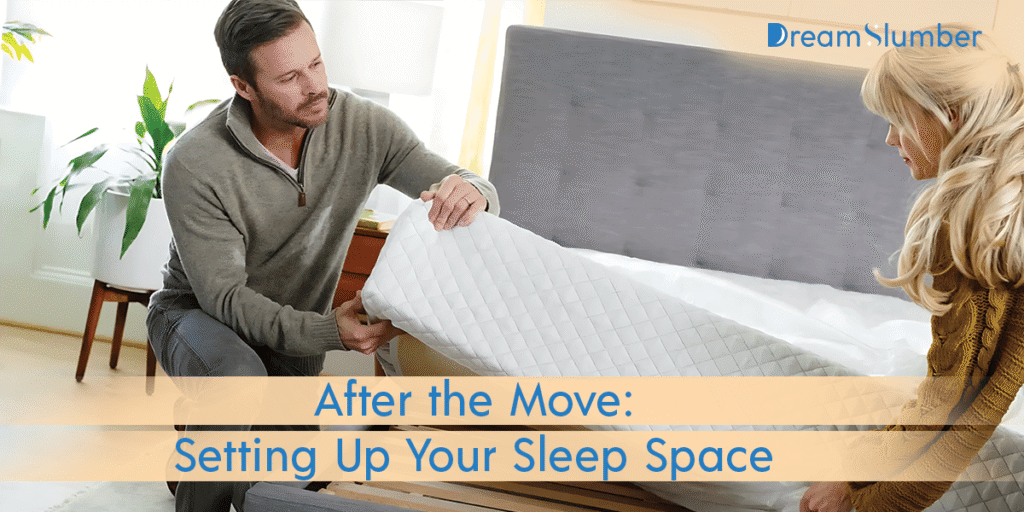When you purchase through our links, we may earn a commission at no extra cost to you. As an Amazon Associate, DreamSlumber earns from qualifying purchases. Learn more.
Moving a latex mattress wrong can cut its life by 30%. Learning how to move a latex mattress saves your money and keeps all the sleep benefits you love. Moving across town or far away? Good handling keeps your body getting the comfort and support that latex gives you.
Latex mattresses need special moving methods due to their build, weight, and materials. This guide helps you move your mattress without damage.
Why Latex Mattresses Require Special Care When Moving
What makes latex mattresses different? They come from rubber tree sap. They’re bouncy and comfy for sleep. But they need careful handling when you move them.
Weight and Density Challenges
Latex mattresses weigh 20-40% more than spring mattresses. A queen weighs over 120 pounds. Kings reach 160 pounds. This heavy latex mattress makes bad moving methods risky.
Unlike memory foam, latex won’t squish easily. It can break if you fold or bend it. The bounce that makes it comfy for sleep makes it hard to move through tight spaces.
Latex is denser than memory foam (5.0-5.9 pounds per cubic foot vs. 3.0-5.0). This makes latex last longer but harder to move.
Latex Mattress Weight Reference Chart
| Mattress Size | Approximate Weight | Helpers Needed |
| Twin | 70-90 lbs. | 2 people |
| Twin XL | 80-100 lbs. | 2 people |
| Full | 90-120 lbs. | 2-3 people |
| Queen | 120-160 lbs. | 3-4 people |
| King | 140-180 lbs. | 4 people |
| Cal King | 140-180 lbs. | 4 people |
Note: These weights vary by latex type (Dunlop tends to be heavier than Talalay), density, and mattress thickness.
Latex vs. Other Mattress Types: Moving Comparison
| Mattress Type | Weight | Flexibility | Main Risks | Special Needs |
| Latex | 90-160 lbs. | Low | Breaking if bent | Must stay flat |
| Memory Foam | 60-110 lbs. | Medium | Compression damage | Can bend slightly |
| Innerspring | 70-130 lbs. | Very Low | Coil damage | No standing on end |
| Hybrid | 80-140 lbs. | Low | Layer separation | Keep flat to protect components |
The 2024 Moving and Storage Report shows that one-third of mattress damage comes from bad packaging, not bad handling.
Types of Latex to Know About
- Dunlop Latex: The first type of latex foam. It’s dense and heavy. The bottom is denser than the top. Lift with extra help from the dense side.
- Talalay Latex: Lighter than Dunlop. It tears more easily, so handle it with care.
- Latex Hybrids: These mix latex top layers with springs below. Keep them flat when moving so layers don’t pull apart. Never stand them up.

Get Ready: Protect Your Latex Mattress
Good planning stops most moving problems. Here’s how to protect your mattress before lifting.
Pre-Move Preparation Checklist (Print this so that you don’t forget anything)
| Pre-Move Task | |
| Clean mattress thoroughly | □ |
| Measure doorways and stairs | □ |
| Purchase mattress bag and protection supplies | □ |
| Arrange help for moving day | □ |
| Clear path from bedroom to vehicle | □ |
| Plan for adequate transportation space | □ |
| Prepare destination space | □ |
Pre-Move Cleaning for Better Hygiene
Before you wrap your mattress, clean it to keep dust, dirt, and stains away from your new home:
- Vacuum with an upholstery tool
- Clean stains with half vinegar, half water
- Sprinkle baking soda on top, let sit 6-8 hours, then vacuum
- Let dry fully for 24 hours before packing
This keeps the hypoallergenic mattress care benefits that latex owners love. It also prevents mold from growing if you pack a damp mattress.
Did You Know? Natural latex fights dust mites and germs. However, preventing mattress mold means drying it fully before wrapping.
Moving Tools You’ll Need
You need these tools to keep you and your mattress safe:
- Heavy-duty mattress bag (try eco-friendly mattress bags made from plant materials)
- Mattress straps or ratchet ties (at least 2 sets)
- Moving blankets (at least 2)
- Furniture dolly with 4 wheels
- Helpers (at least one, better to have two)
- Breathable mattress cover for your new home
- Packing tape (paper-based is better for the earth)
- Furniture sliders for hard floors
- Grip gloves
Tip: If you get this mattress bag, you won’t need any other items to move your mattress. It is also good for long-term storage.
Using Original Packaging
If you kept the original box and packing, use it! It offers big help:
- Fits your exact mattress model
- Has boxes for latex layers (for layered mattresses)
- Uses materials the maker approved to prevent damage
For layered latex mattresses like Spindle or SleepEZ, take the mattress apart. Use the original boxes for best protection.
Expert Tip: Robert Carucci, moving expert with 15 years of experience, says: “The key to a good latex mattress move is prep work. The most important thing is a good mattress bag. Never skip it, even for short moves.”
Measuring Before You Move
Before moving day, measure all doorways, halls, stairs, and elevators your mattress will go through. Compare them to your mattress plus 2-4 inches for covers.
| Passage Point | Minimum Width Needed | Challenges | Tight Space Solutions |
| Doorways | Mattress width + 4″ | Door hinges reduce clearance | Remove door from hinges if needed |
| Hallways | Mattress width + 6″ | Turning corners | Use slight curve (not folding) |
| Stairs | Mattress width + 8″ | Railing clearance | Brief vertical position while moving |
| Elevator | Mattress diagonal length | Ceiling height | Consider stairs if too tight |
What if your mattress won’t fit through some spaces? For layered latex, take it apart. For one-piece latex, hire movers with special tools.

Step-by-Step: How to Move a Latex Mattress
Moving needs careful steps to keep your mattress and body safe. This guide helps if you’re trying to move a latex mattress by yourself (though we strongly suggest getting help) or with others.
Taking Apart Layered Latex Mattresses
Many nice latex mattresses have layers you can take apart for easier moving:
- Get Ready
- Clear a clean, dry floor space bigger than the mattress
- Take off all bedding and the mattress cover
- Take photos of how layers stack up
- Label each layer with tape
- Taking Apart
- Start from the top layer, peel it away gently
- Have help support both ends to stop folding
- Put each layer flat on a clean spot right away
- Wrap each layer in breathable bags
- Use tape to secure, don’t let tape touch the latex
- Putting Back Together
- Set up the base or frame first
- Start with the bottom layer, follow your labels
- Line up each layer before adding the next
- Put the cover back on right after assembly
- Wait 24 hours before sleeping on it
Safe Lifting to Avoid Injury
How can you safely lift a 100+ pound mattress? DIY mattress moving needs good body form:
- Clear the path first
- Stand at the mattress side, not the end
- Bend your knees, keep your back straight
- Grip from under the mattress at the midpoint
- Lift with leg muscles, not back
- Move slowly with small steps
- Talk with your moving partner
- Say “Lift on three” to work together
- Rest every 30 feet on long moves
Wellness Tip: Prepare your body for moving day with gentle stretching exercises focusing on the lower back and hamstrings the day before.
How to Move a Latex Mattress by Yourself (When Absolutely Necessary)
While not recommended, sometimes you might need to move a smaller latex mattress (Twin or Twin XL) without help:
- Use a quality mattress bag with built-in handles
- Use furniture sliders underneath on hard floors
- Use the “caterpillar method” – move one end at a time in an inching motion
- Never try to carry the full weight – always slide when alone
Remember, even the lightest latex mattresses weigh over 70 pounds. If you doubt your ability to move it safely alone, wait for help.
Vehicle Loading: Best Ways
What’s the best vehicle for mattress transport? Use a covered moving truck with enough flat space to lay the mattress flat. If using a pickup truck, make sure the mattress:
- Stays flat (never folded)
- Has a waterproof mattress bag
- Is tied down with at least two straps
- Has support under its whole length
- Doesn’t stick out too far
| Vehicle Type | Max Mattress Size | Special Considerations |
| Pickup Truck | King (with cap)/Queen (open) | Weather protection is critical; use a tarp in open beds |
| Large SUV | Queen (may require seat removal) | Ensure completely flat positioning |
| Cargo Van | King | Best DIY option; secure from sliding |
| Box Truck | All sizes | Ideal option; secure from movement |
Moving Room-to-Room vs. Long Distance
The way you move a latex mattress depends on how far you’re going:
For room-to-room moves:
- Clear a full path first
- Use furniture sliders under corners on hard floors
- Get at least two people to help
- Move in stages with rest breaks
- Take apart heavy mattresses if possible
For long-distance moves:
- We strongly suggest hiring pros for moves over 100 miles
- Keep the mattress flat the whole trip
- Check tie-downs at every stop
- Keep climate control on when possible
- Don’t put items on top of the mattress
DIY vs. Hiring Professional Movers
Should you move it yourself or hire pros? This choice affects your mattress life and your safety.
| What to Consider | DIY Moving | Professional Movers |
| Cost | $50-100 (for supplies) | $200-400 (service fee) |
| Time | 2-4 hours | 30-60 minutes |
| Risk to You | Medium-High | Low |
| Risk to Mattress | Medium | Low |
| Vehicle Needed | Large truck/van | Included in service |
| Equipment Needed | You provide | Included in service |
Professional mattress movers trained in handling specialty sleep surfaces might be worth considering for:
- Multi-story buildings
- Long-distance moves
- Those with physical limitations
- Particularly expensive or heavy latex models
- Limited access situations (narrow stairwells, small elevators)
Also read:
- What Is a Cold Foam Mattress?
- Can I Put a Mattress in a Dumpster?
- Do Mattress Covers Make You Sweat?

After the Move: Setting Up Your Sleep Space
How do you get your latex mattress working best in your new place?
Post-move mattress setup steps:
- Take off all covers outside if you can
- Check for any damage or wet spots
- Let it breathe without covers for 24 hours in a room with air flow
- Put on a fresh mattress cover before making the bed
- Place on the right base (slats with gaps under 3″ work best)
- Wait 24-48 hours before sleeping on it, if possible
- For layered mattresses, follow the maker’s instructions
Latex has great bounce-back power, but it still needs rest after a move. This wait makes it more comfy and helps it last longer.
Finding the Best Placement in Your New Space
How you position your latex mattress affects sleep quality and how long it lasts:
- Keep at least 6 inches away from heating vents and radiators
- Don’t place directly against exterior walls in humid climates
- Keep away from direct sunlight to prevent damage
- Make sure air can flow around all sides
- Try a north/south orientation for better sleep
How Long Should a Latex Mattress Rest After Moving?
After transport, your latex mattress benefits from a recovery period:
| Rest Type | Minimum Time | Ideal Time | Purpose |
| Unpacked Airing | 12 hours | 24 hours | Allow moisture to evaporate |
| Structure Recovery | 24 hours | 48 hours | Permit latex cells to recover shape |
| Layer Settling | 24 hours | 72 hours | Allow multi-layer mattresses to align |
| Odor Dissipation | 12 hours | 48 hours | Eliminate packaging odors |
Sleep Wellness Insight: The first night on your properly set-up latex mattress after a move is a perfect time to practice sleep hygiene.
Mistakes That Damage Latex Mattresses
Avoid these errors that can hurt your mattress forever:
What Not to Do
- Can latex mattresses be folded? No, never. Even folding for a short time can break the inside structure.
- How do you roll up a latex mattress? Don’t. Unlike some foam mattresses, latex can’t be rolled safely.
- Dragging instead of lifting (causes tears)
- Standing upright for long periods (makes layers shift)
- Using just plastic wrap (traps moisture, causing mold)
- Putting heavy things on top during moving (squishes and damages it)
- Leaving in direct sunlight while moving (breaks down the material)
What vs. How: Correct Approach to Latex Mattress Moving
| What to Avoid | What to Do Instead | Why It Matters |
| Folding the mattress | Keep completely flat or slightly curved | Prevents structural damage to latex foam |
| Using rope or thin straps | Use wide, padded mattress straps | Avoids creating pressure points |
| Dragging across floors | Use a dolly or furniture sliders | Prevents cover tearing and abrasion |
| Moving without proper coverage | Use a proper mattress bag | Protects from dirt, moisture, and damage |
| Lifting from the edges | Lift from underneath at structural points | Prevents stretching and tearing |
Dr. James Mallory, mattress expert, says: "The cell structure that makes latex comfy also makes it easy to damage. The biggest mistake is treating latex mattresses like spring mattresses."
Eco-Friendly Disposal and Recycling Options
If your move coincides with replacing your latex mattress, consider these disposal options:
- Recycling latex foam through specialized programs (70% of latex materials can be repurposed according to the Green Sleep Initiative’s 2025 report)
- Donation to shelters that accept used mattresses
- Manufacturers take-back programs (Savvy Rest, PlushBeds, and Avocado offer these services)
- Material separation for component recycling (covers, latex layers, and foundations)
The average latex mattress lifespan ranges from 12-20 years, significantly longer than conventional mattresses. This durability makes proper moving techniques especially valuable for preserving your investment.
Local Recycling Resources for Natural Mattresses
Finding proper disposal options depends on your location. Use these resources:
- Earth911’s recycling locator (searchable by material type and zip code)
- Mattress Recycling Council programs (CA, CT, and RI have mandatory mattress recycling)
- Local waste management department’s special item pickup services
- Manufacturer websites for take-back program availability

Frequently Asked Questions
Can you fold a latex mattress during a move?
No, never fold latex mattresses. Unlike foam, latex is like rubber and gets damaged when creased. Always keep it flat or just slightly curved.
How do you roll up a latex mattress?
Don’t roll a latex mattress. Unlike some foam mattresses made for rolling, latex must stay flat. Rolling hurts the structure and makes it less comfy. For layered latex mattresses, take apart the layers and move them one by one.
How heavy is a latex mattress?
Latex mattresses weigh 20-40% more than regular ones. A queen-size latex weighs 120-160 pounds while a normal spring mattress weighs 80-100 pounds. This latex mattress weight means you need good lifting methods and enough help.
Do I need a mattress bag for moving latex?
Yes, you must use a heavy-duty mattress bag. Try eco-friendly mattress bags made from plant materials. These keep out moisture, dirt, and prevent tears while being better for the earth.
What’s the best vehicle for moving a latex mattress?
A covered moving truck with flat space works best. The best vehicle for mattress transport lets the mattress lay flat. Most queen and king latex mattresses don’t fit well in pickup trucks or SUVs.
How to move a latex mattress by yourself?
Moving a small latex mattress alone is hard but possible. Use sliders on hard floors, a mattress bag with handles, and move in small steps. Don’t try to move any mattress larger than a twin by yourself. Get help or hire pros for bigger sizes.
Conclusion
Learning how to move a latex mattress right saves more than money. It keeps you sleeping well. Latex mattresses give great comfort, stay cool, and fight allergens. All these help you sleep better.
Following these latex mattress moving tips helps your mattress work well in your new home. Your mattress is the basis of good sleep – a key part of your health worth protecting. Sleep wellness doesn’t need to be disrupted by a move. With good planning, the right help, and proper methods, your latex mattress can keep giving you great sleep in your new home, helping your health and energy.


